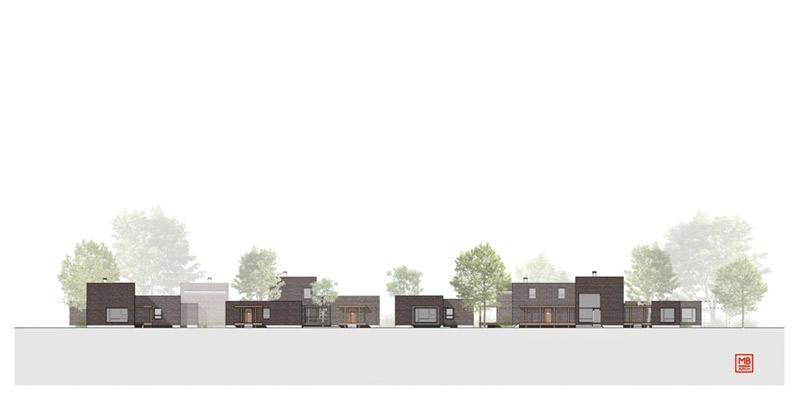With its last effort at creating affordable housing legislation struck down by the New York State Supreme Court in April, the Sag Harbor Village Board introduced a new affordable housing initiative at last week’s board meeting, “just to start the conversation,” said Mayor Tom Gardella.
“Preliminary Draft for Review” was written in big red letters across the top of the document, highlighting the fact that the village is back starting anew, trying, once again, to tackle a seemingly intractable issue.
The board took a smaller, though perhaps more immediately consequential, step by proposing to lower the minimum size of accessory structures containing an apartment from 500 square feet to 280 square feet. That requires a code amendment and will be debated at a public hearing at the next board meeting, on Nov. 14.
The planning analysis by Nelson Pope Voorhis proposed a “new strategy” to help the village advance its affordable housing goals. Noting that the village’s old law was overturned “largely based on an implied connection between the local laws and a specific development application” (namely Adam Potter’s proposal for a mixed-use building bordered by Rose, Bridge, and Meadow Streets) the consultants said a “floating zone” would create “The opportunity for a desirable use without tying it to any particular parcel.”
They acknowledged, however, that a similar moderate-income residence floating zone was part of the village code from 1984 to 2009 and failed to generate any applications. But times have changed, they argued, and the affordable housing crisis is worse than ever.
A floating zone is not applied over an entire district in the way that there is a bounded office or waterfront district with specific zoning laws that pertain to it. Instead, it hangs over the entire zoning code, and an applicant wishing to put a project into a zone that doesn’t specifically allow it must apply to the village board for a change of zone.
At first read, it seems to put the board back front and center in the business of reviewing housing projects, a responsibility it attempted to distance itself from in August.
However, under the proposal, while the board must initially sign off on the conceptual development proposal, the planning board would “maintain its jurisdiction regarding site plan review.” The village board could also ask the planning board to help review the conceptual proposal and ultimately, the planning board, not the village board, would determine the environmental impact of a project. Other boards could be involved as well. For example, large swaths of the village are considered part of a historic district, and “an adverse report from the Board of Historic Preservation and Architectural Review could be considered sufficient grounds for denial of the change of zone,” reads the draft initiative.
Ed Haye, the deputy mayor, said that the floating zone “gives the village and the residents an opportunity to look at each project on its own.” If the board decided a project was not in the public interest, “We don’t have to consider it, because it would require a zoning change and we don’t have to contemplate a zoning change from the get-go.”
“No problem is more severe than the lack of affordable housing,” said Tiffany Scarlato, not this week, but 15 years ago, in the “Draft Village of Sag Harbor Local Residential Housing Plan,” which she co-authored with Greg Ferraris. Ms. Scarlato has since advised Adam Potter, and she said in a phone call that the floating zone is “a sound idea used in a lot of municipalities. It gives the village more wiggle room on how affordable housing can occur. They have a direct say in where the zone lands.”
“It’s a hard thing to say out loud: We need a building with 60 units,” she said.
Eric Schantz, the director of housing for East Hampton Town, said 40 to 50 units are the most obvious way to tackle the affordable housing crisis, but that community housing fund money could also be used to provide “direct financial assistance to first time homebuyers.”
“Part of the puzzle is A.D.U.s [accessory dwelling units]. I envision sometime next year we will have a Town of East Hampton program for giving money for building A.D.U.s for homeowners,” though he said details have yet to be worked out.
But floating zones don’t have to be used only in service of large projects, which is just fine with Mayor Gardella, who seems more comfortable with a decentralized take on housing. “The village is only 2.2 square miles. We want to preserve our way of living and A.D.U.s can do that.” He mentioned the New York State Plus One A.D.U. Program that could award a homeowner with up to $125,000 to construct such a unit. So between the town and state, perhaps enough incentive will exist for homeowners to build accessory dwelling units in the same way they are now incentivized to install I/A septic systems.
“I’m against overdeveloping,” the mayor said. “There are only certain areas in the village where you could possibly do something, and I don’t think that’s going to contribute to the quality of life for current residents.”
One spot that Mayor Gardella expects affordable housing to go is at the emergency medical service headquarters at 1357 Noyac Road. The plan would require moving the village’s Department of Public Works up the Bridgehampton-Sag Harbor Turnpike, to the impound lot. “It’s very preliminary, but we have sectioned off part of the project for affordable housing.”
In an informal presentation, Maziar Behrooz, an architect who lives in Sag Harbor, showed the mayor and a group of concerned citizens a sketch of how his modular-based architecture (“Like Legos, infinitely adaptable,” he said) could create a neighborhood-based solution to the housing crisis. “The plans I showed used a mix of every building component from our collection, creating a sense of variety and diversity, as opposed to an out of proportion monolithic facade.” In fact, one of the building blocks of his system is called the cottage, at just 293 square feet, the perfect size for an accessory apartment.
“I don’t use the word affordable, I say reduced cost,” Mr. Behrooz said of his housing components (there are seven standalone modules, with multiple accessories that can be added). “I don’t think of this as my affordable housing, I think of it as a way of designing buildings, period.” Because they could be prefabricated, “they could cost 30 to 40 percent less than standard on-site construction costs in the East Hampton market.”
“I think it’s a good idea,” said Susan Mead, co-president of the Sag Harbor Partnership said of a floating zone. It would allow the village to keep nonconforming multifamily houses, multifamily, so they’re not converted to single family homes. “At one time we had a huge number of structures that were rooming houses that have been converted to single family homes. That’s not where we should be right now.”
This story has been updated to clarify Mr. Behrooz's estimated cost of prefabricated units.




